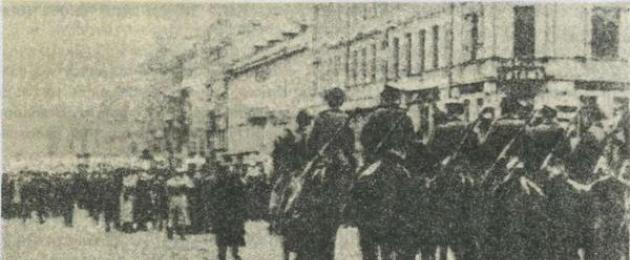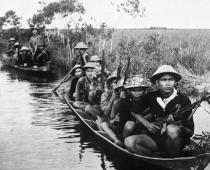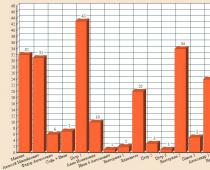Russian Revolution 1905-1907 refers to the number of late bourgeois revolutions. 250 years separated it from the English revolution of the 17th century, more than a century from the Great French Revolution, more than half a century from the European revolutions of 1848-1849. The first Russian bourgeois revolution was different from its predecessors in European countries. This was explained, first of all, by the fact that the level of Russia's economic development by the beginning of the 20th century, the severity of class contradictions, and the degree of political maturity of the proletariat were significantly higher than in the West on the eve of the first bourgeois revolutions.
The immediate causes of the revolution were the economic crisis of 1900-1903. and the Russo-Japanese War. 1905 began with a big strike of workers at the Putilov factory in St. Petersburg. The revolution was triggered by the events of January 9, when the priest Gapon, who was connected simultaneously with the Socialist-Revolutionaries and the Okhrana, organized a procession of workers to the Winter Palace to present a petition to the Tsar. It set out demands to improve working conditions, introduce political freedoms, convene a Constituent Assembly, etc.
About 140 thousand people, including old people, women, children, festively dressed, came out on Sunday morning with icons and portraits of the king. With hope and faith in the sovereign, they moved to the Winter Palace. They were met with gunfire. As a result, about 1,200 people were killed and over 5,000 wounded. The senseless and brutal massacre shook the country.
After January 9 (“Bloody Sunday”) protest strikes took place in many cities. In St. Petersburg, the workers began to build barricades. Strikes, demonstrations, clashes with the troops swept across the country.
The alignment of political forces
The main issue in any revolution is the question of power. In relation to him, various socio-political forces in Russia united in three camps. The first camp consisted of supporters of the autocracy: the landowners, the highest ranks of state bodies, the army, the police, and part of the big bourgeoisie. They advocated the creation of a legislative body under the emperor.
The second camp is liberal. It included representatives of the liberal bourgeoisie and the liberal intelligentsia, the advanced nobility, the petty urban bourgeoisie, office workers, and part of the peasants. They proposed peaceful democratic methods of struggle and advocated a constitutional monarchy, universal suffrage and a legislative parliament.
In the third camp - revolutionary-democratic- included the proletariat, part of the peasantry, representatives of the petty bourgeoisie, etc. Their interests were expressed by the Social Democrats, Socialist-Revolutionaries and some other political forces. They advocated the demolition of the autocracy and the establishment of a democratic republic.
Revolution on the rise
From January to March 1905, about 1 million people took part in the strikes. In the spring and summer, revolutionary events intensified. During a two-month strike of workers in Ivanovo-Voznesensk, the first Soviet of Workers' Deputies in Russia was created, which became an organ of revolutionary power in the city.

On August 6, in the context of the development of the revolution, the tsar issued a Manifesto on the establishment of a legislative body - the State Duma. Under the electoral law, most of the population (women, workers, military personnel, students, etc.) was deprived of voting rights. Therefore, the supporters of the liberal and democratic camps came out in favor of a boycott of this Duma.

In October 1905, about 2 million people (workers, employees, doctors, students, etc.) took part in the All-Russian political strike. The main slogans of the strike were demands for an 8-hour working day, democratic freedoms, and the convening of a Constituent Assembly.
Manifesto October 17, 1905
Frightened by the further development of the revolution, Nicholas II signed the Manifesto on the abolition of the unlimited monarchy in Russia. The emperor considered it necessary to “grant the population the unshakable foundations of civil freedom”: inviolability of the person, freedom of conscience, speech, press, meetings and unions, representative government - legislative State Duma. Significantly expanded the circle of voters.
In the conditions of the upsurge of the revolution of 1905, the Manifesto was a concession to the autocracy, but it did not bring the desired reassurance.
Formation of new political parties
During the revolution, the "old" political parties (RSDLP and Socialist-Revolutionaries) were strengthened. At the same time, new parties emerged. In October 1905, the first legal political party in Russia was created - the Constitutional Democratic Party (Party of Cadets). The well-known historian P. Milyukov became its head. It included representatives of the middle commercial and industrial bourgeoisie. Soon after the Manifesto of Nicholas II, the Union of October 17, or the Octobrists, was created, a political party headed by the Moscow industrialist A. Guchkov. It included representatives of large landowners, industrial-financial and commercial bourgeoisie. Both of these parties stood for the speedy end of the revolution, for political freedoms within the framework of the Manifesto of October 17 and the creation of a constitutional-monarchist regime in Russia.
Performances in the army and navy
In the summer and autumn of 1905 there were mass demonstrations in the army and navy. In June, an uprising broke out on the battleship Potemkin. The sailors hoped that other ships of the Black Sea Fleet would join them. But their hopes were not justified.
"Potemkin" went to the coast of Romania and surrendered to the local authorities.
In October - December, there were about 200 performances by soldiers in different cities, including Kharkov, Kiev, Tashkent, Warsaw. At the end of October, a riot of sailors broke out in Kronstadt, but was suppressed. In November, the sailors of the cruiser Ochakov rebelled in Sevastopol. The ship was shot from fortress guns and sunk.
December armed uprising
It was the pinnacle of the events of 1905. About 6,000 armed workers took part in it. Up to 1,000 barricades were erected in Moscow. The tactics of the barricade struggle of the workers' squads were combined with the actions of small combat detachments. The government managed to transfer troops to Moscow from St. Petersburg, and the uprising began to weaken. Presnya, a working-class area near the Prokhorovskaya manufactory, resisted most stubbornly. On December 19, the uprising in Moscow was crushed. Many of its members were shot. With the help of troops, the government succeeded in suppressing the armed uprisings of workers in other Russian workers' centers (Sormov, Krasnoyarsk, Rostov, Chita).
National Liberation Movement
Revolutions of 1905-1907 sparked a national movement. Demonstrations and rallies demanding the equality of nations, granting national regions "internal self-government" took place in Poland and Finland. They were supplemented by demands for the right to receive education in their native language and the right to develop national culture, which were voiced in the Baltic States, Belarus, Ukraine and the Transcaucasus.
During the revolution, tsarism was forced to allow the printing of newspapers and magazines in the languages of the peoples of Russia, as well as teaching in schools in their native language. National parties of a socialist orientation arose and actively operated - the Polish Party of Socialists, the Belarusian Socialist Community, the Jewish Bund, the Ukrainian Spilka, the socialists of Georgia, etc.
On the whole, the national movement in the border regions merged with the revolutionary struggle against tsarism.
I and II State Dumas
In April 1906, the State Duma solemnly opened in the Tauride Palace in St. Petersburg. It was the first legislative assembly of people's representatives in the history of Russia. Representatives of the bourgeoisie and the peasantry predominated among the deputies. The Duma put forward a project to create a nationwide land fund, including at the expense of part of the landlords' lands. This did not please Nicholas II. On his instructions, after having worked for three months, the First State Duma was dissolved.
The II State Duma began its work at the end of February 1907. The deputies were elected according to the old electoral law. She became even more naughty. Then, several dozen deputies were arrested on charges fabricated by the Okhrana in an anti-state conspiracy. On June 3, the Second State Duma was dispersed. The government introduced a new electoral law. Since it was adopted without the approval of the Duma, this event went down in history as the "June 3rd coup d'état", which meant the end of the revolution.
The results of the revolution
The revolution not only significantly changed the life of the country, but also influenced the change in the political system of Russia. A parliament was introduced in the country, consisting of two chambers: the upper - the State Council and the lower - the State Duma. But a constitutional monarchy of the Western type was not created.
Tsarism was forced to come to terms with the existence in the country of various political parties and the "Russian parliament" - the State Duma. The bourgeoisie was involved in the implementation of economic policy.
In the course of the revolution, the masses of the people gained experience in the struggle for freedom and democracy. Workers were given the right to form trade unions and savings banks, to participate in strikes. The working day was streamlined and shortened.
The peasants were equalized with other classes in civil rights; since 1907 redemption payments for land received by them under the reform in 1861 were abolished. However, the agrarian issue was not resolved in the main: the peasants still suffered from land shortages.
THIS IS INTERESTING TO KNOW
On the eve of Bloody Sunday, the capital's garrison was reinforced by troops called in from Pskov and Reval (Tallinn). An additional 30,000 soldiers were brought into St. Petersburg. The commanders convinced the soldiers that on January 9 the workers wanted to destroy the Winter Palace and kill the tsar. When workers from the outskirts moved towards the Winter Palace, the police and soldiers blocked their way.
At the Narva Gates, on the Petersburg side and Palace Square, the troops opened fire with volleys at the columns of workers. Following this, the workers were attacked by the cavalry, who cut them with sabers and trampled them with horses.
The government report, which was published in the press on January 12, indicated that during the events of January 9, 96 people were killed and 333 wounded.
References:
V. S. Koshelev, I. V. Orzhehovsky, V. I. Sinitsa / World History of the Modern Times XIX - early. XX century., 1998.
- In contact with 0
- Google+ 0
- OK 0
- Facebook 0








